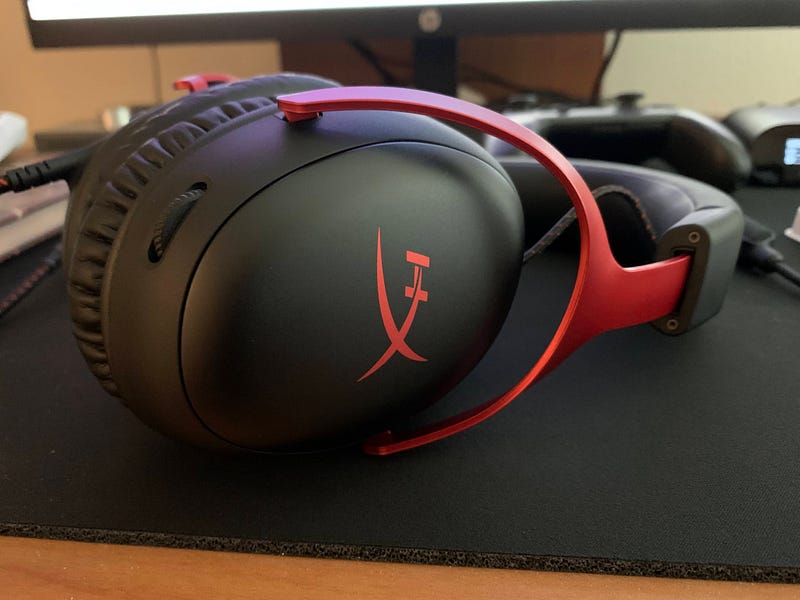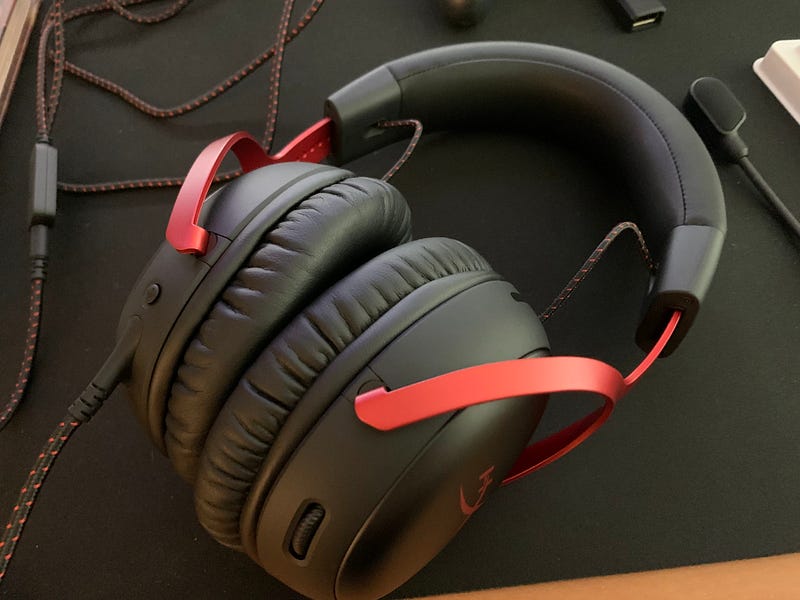HyperX Cloud III Headset Review: A Long-Awaited Update
Written on
Chapter 1: Introduction to the Cloud III
It feels as though I’ve been anticipating a headset called “HyperX Cloud III” for nearly a decade—because it has indeed been that long. The groundbreaking HyperX Cloud II debuted in 2015, a swift upgrade from the original Cloud I, which itself was built on the Qpad QH90 design. This design was essentially a Takstar Pro 80 studio headphone, an OEM Beyerdynamic clone, enhanced with a microphone.
From this eclectic foundation, HyperX developed a comprehensive gaming audio brand. The Cloud II set new standards for gaming sound quality, shifting away from an overwhelming bass focus to something resembling studio monitor clarity. While still maintaining a v-shaped sound profile, it was executed with finesse, and its reliable noise-canceling microphone ensured clear communication over chat channels, even if the voice quality resembled an old phone line.
Throughout the past eight years, HyperX has unveiled several models that I believed deserved the “III” designation. The 2017 Cloud Alpha, for instance, arrived at the same price point with a completely revamped design and improved performance. Surprisingly, HyperX chose to continue selling both models, leaving consumers puzzled over which to choose for their $99 investment.
In 2019, the company introduced a USB surround dongle for the Alpha, along with new ear pads and an acoustic bass tuning feature. Although a USB dongle was touted as a differentiator between the Alpha and standard Cloud lines, this was not always consistent. A lesser-known variant, the Cloud Alpha S, further complicated the product lineup, remaining available in stores despite not being stocked for years.
The Cloud II Wireless emerged in 2020, retaining the core speaker drivers but featuring a sleek new industrial design, enhanced aluminum forks, improved ear pads, and an authentic 7.1 DAC/amp. I felt this justified a “Cloud III” title, yet it didn’t materialize as such. A more recent revision of this model removed the amp in favor of a simplified version reliant on HyperX’s lagging processing software.
Finally, after what feels like an eternity, the Cloud III has arrived—though it seems tardy both to its own launch and the gaming headset market at large. I purchased my unit from Best Buy after a frustrating month of “soft launch” status, where the HyperX website was the primary source of information. After using the headset for over a week, I’m now seeing it become more widely available in the U.S.
OVERVIEW
The Cloud III maintains the same $99 price point that its predecessors and the Alpha have held for years. It remains a wired headset, complete with a USB dongle. The cable is permanently attached, though the microphone is detachable. By default, the USB dongle connects to a USB-C port, but it includes a USB-A adapter that I found challenging to detach initially. Other than that, the box contains no additional accessories.
Fortunately, the core aspects of this headset—sound, design, padding, and microphone—are entirely new. It adopts the aesthetic introduced by the Cloud Stinger 2 last year, representing more than just a cosmetic update; it genuinely deserves its own numerical designation, even if it feels as though it has arrived late to the gaming audio party. However, some lingering issues with the dongle and an outdated feature set prevent it from achieving its full potential as a market leader.

Chapter 2: Comfort and Sound Quality
THE GOOD: COMFORT
This headset is arguably the most comfortable gaming accessory available today. I say "arguably" because I can only assess it based on my own experience, and individual head shapes may lead to different comfort levels.
Every aspect of the Cloud III appears to prioritize comfort. The frame has been refined to ensure an ergonomic fit, with a headband that is plush and soft, surpassing any other model in the HyperX range. The ear pads are generously sized, containing more memory foam than most HyperX designs, except perhaps for the older Revolver headsets.
The headband offers a greater range of adjustment compared to the Cloud II. I found that I needed the maximum extension on that model, while the Cloud III allows me to use it at about two-thirds of its length. The ear cups don’t lay flat for comfortable neck-wearing, but they do have lateral swivel to create a good seal.
Inside the ear cups, the drivers are now angled like the Alphas, providing more space for your ears. If there’s still contact with the internal wall, a layer of foam padding alleviates discomfort.
I can comfortably wear these for hours without any complaints. The closed-back design, paired with leatherette padding, does lead to some heat build-up after an extended period, but that’s simply a physical reality.
SOUND QUALITY
Initially, I wasn’t thrilled with the sound quality of the Cloud III, but it grew on me over the week. I anticipated an evolution of the beloved Cloud II sound profile, but instead, I encountered something entirely new.
The original Cloud II featured a slightly pronounced v-shaped sound profile akin to the Beyerdynamic DT770 studio headphones. It offered enjoyable sub-bass, detailed mids, and sparkling treble that some may have found overly sharp for certain audio. This sound profile was delightful for gaming and music, proving more accurate than most gaming headsets of its time.
Conversely, the Cloud III presents a distinct sound signature. The bass is more neutral, with emphasis shifted toward the upper range rather than the lower. The mids feel somewhat subdued, lacking the vibrant edge of the previous model. The treble is refined and accurate, though perhaps less engaging at first listen.
It seems the Cloud III was designed primarily for spatial listening accuracy. The soundstage is expansive and immersive in stereo, becoming even more pronounced when paired with a spatial audio system. I tested it with both DTS Headphone and Sony’s Tempest 3D audio, and it provided an exceptional sense of spatial awareness compared to other closed headsets in my collection.
However, the downside is that these headphones may not deliver the same level of enjoyment for music listening as the older model. They lack the immediate excitement found in the previous version. Nevertheless, if you’re keen on picking up spatial cues in video games, the Cloud III will surely impress.
The HyperX Cloud III Review - Replacing a LEGEND is Hard
The first video, titled "HyperX Cloud III Review - Replacing a LEGEND is Hard," offers a comprehensive look at the headset's features and performance. The video dives deep into the pros and cons, shedding light on whether it lives up to the legacy of its predecessors.

MIC QUALITY
The microphone may just be the standout feature of the Cloud III, despite the new aesthetics and remarkable comfort. This microphone is exceptional, outperforming those on nearly every other HyperX headset and rivaling options from other gaming brands.
This marks a significant improvement over the older Cloud II mic, which, while decent in noise cancellation, produced a somewhat tinny sound. In contrast, the new mic delivers robust audio quality with an enhanced treble edge that enhances clarity in online chat applications.
Additionally, the mic now features a built-in pop filter, and HyperX has introduced a mute light that indicates when the mic is off. This is especially handy, even when connected to devices like console controllers.
Good But Not for Everyone - HyperX Cloud 3 Detailed Review and Mic Test
The second video, "Good But Not for Everyone - HyperX Cloud 3 Detailed Review and Mic Test," provides an in-depth evaluation of the headset's microphone capabilities alongside its overall performance.
Chapter 3: Connectivity Challenges
DONGLE FRUSTRATIONS
I had hoped the new Cloud III dongle would avoid the latency issues associated with HyperX's DTS and EQ driver. Unfortunately, upon plugging it in and launching Ngenuity, I was greeted with a notification indicating that using the drivers would introduce noticeable audio latency.
While a few milliseconds might be acceptable, the delay here is significant—easily perceptible. This issue was frustrating with their recent wireless models and persists in this wired version. For those wanting to use spatial audio on Windows, it’s advisable to rely on the built-in Windows Sonic system or to download the separate DTS Sound Unbound app.
UPDATE 2 8/30/23: I've resolved the sidetone issue described earlier. It turns out the headset dongle features "dynamic sidetone," meaning the toggle in the software merely enables or disables this mode rather than activating sidetone outright. When toggled on, it attempts to detect microphone usage, but it doesn’t always function correctly.
Chapter 4: Outdated Design Choices
It's peculiar that the Cloud III launched as a wired headset in 2023, particularly when the wireless market is currently thriving. I would have expected a major release like the Cloud III to debut alongside a wireless version.
Even considering this as a wired product, it feels somewhat outdated, especially at this price point. The permanently attached cable is disappointing, limiting user repairability. While this design may enhance mic quality, it restricts flexibility. Other brands have tackled mic crosstalk with five-pin connections, which are more durable.
Equally surprising is the inclusion of a dedicated dongle. Consoles like the PS5 and Xbox Series provide excellent sound output through controller jacks, making the dongle somewhat redundant. Most modern PCs and gaming laptops also boast superior motherboard audio compared to 2015, when the Cloud II was released.
Chapter 5: Market Position and Conclusion
The Cloud III could easily serve as HyperX's sole offering at the $99 price point, yet, similar to 2017, it will continue to coexist with the Alpha. While I understand the Alpha's popularity, this creates confusion for consumers. The Cloud III excels in microphone quality, soundstage, and comfort, while also featuring an arguably unnecessary dongle—all at the same price.
The $99 market is saturated with excellent alternatives, despite the exceptional comfort of the Cloud III. HyperX's Stinger 2 Wireless offers the wireless feature many users desire. Razer's Barracuda X 2022 includes both wireless and Bluetooth capabilities, while Turtle Beach's Recon 500 delivers fantastic sound at a lower price. The Arctis Nova 3 offers a more modern approach to connectivity at the same cost.
As yet another addition to HyperX's extensive product line, the Cloud III's role feels unclear beyond being a "good replacement for the Cloud II." Many gamers might find satisfaction with the more affordable Stinger 2 series, except for those who prioritize soundstage and comfort above all.
FINAL THOUGHTS
I appreciate the core design of this headset. If it had a detachable cable and a flexible design, replacing the latency-inducing dongle with a carrying bag, I’d fully endorse it. The comfort is arguably the best available, the sound is adeptly tuned for gaming, and the design is appealing, complemented by an impressive microphone.
Since 2015, the market has learned valuable lessons, many derived from the Cloud II itself. The new Cloud III is a better-engineered version of its predecessor, sporting a bold new sound profile. However, that alone may not suffice to dominate the market.
While I’m glad this headset has finally been released, I anticipate it will struggle to achieve the same iconic status as its predecessor. It certainly deserves the Cloud name, but it may no longer hold the title of the gold standard.